Categories: Featured Articles » Sources of light
Number of views: 105004
Comments on the article: 5
Classification and labeling of LED lamps
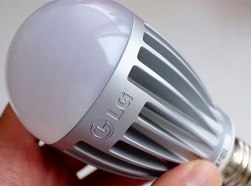 Modern LED lamps can be classified according to several criteria:
Modern LED lamps can be classified according to several criteria:
-
for the purpose of the lamp;
-
by type of construction;
-
by type of cap;
-
according to the properties of the emitted light.
By designation, LED lamps are divided into:
-
lamps of the main lighting in premises;
-
lamps for local design highlights;
-
lamps for exterior architectural lighting and landscape design;
-
lamps for use in explosive atmospheres;
-
lamps for lighting streets, parking lots, bridges, sidewalks, railway stations, etc .;
-
lamps for floodlights that are installed on industrial buildings and territories.

By type, depending on other properties, LED lamps are divided into:
-
general-purpose lamps for residential and office premises;
-
directional lamps for spotlights, which are applicable both for local illumination of building interiors, shop windows, advertising structures, and for landscape lighting;
-
linear lamps in the form of elongated tubes, to replace fluorescent lamps.
According to the type of cap, there are mainly five main types:

Sockets E27, E14
The standard threaded connection found on most ordinary incandescent lamps. This type of cap was introduced by Edison himself, and the letter "E" is the first letter of the inventor's name. The numbers indicate the diameter of the cap in millimeters.
Today, the socles E27, E14 and their other sizes, are the most common types among all the socles, including among LED lamps. The cap E14 is also called the "minion". Bulbs with such a base usually have a bulb in the shape of a candle, an elongated shape, and are used mainly in sconces, floor lamps, and table lamps.

GU10 base
A two-pin connector, the pins of which have bulges at the ends, designed for rotatable mounting of the lamp in the cartridge. Such socles have, for example, starters in old discharge lamps, which were widely used before in public places. The letters in the name of the cap indicate the following: G - pin cap, U - with bulges at the ends. 10mm is the distance between the pins.
This type of base is the most electrically safe, it is convenient to use, and LED lamps with such a base, as a rule, are designed for a voltage of 220 volts. Mostly, lamps with such a base are those that are installed in ceiling lights (LED reflector lamps).

GU5.3 base
Sockets of the GU5.3 type, sockets of the same pin family, have been widely used recently, when halogen reflective lamps in ceiling lights became massively distributed. Basically, this is a spotlight mounted in plasterboard ceilings.
LED lamps with such a base came to replace halogen lamps with a similar base, and easily mounted in cartridges. The holes in the cartridges for this socle correspond exactly, the distance between the pins exactly matches the holes, and is 5.3 mm, so the installation is quite simple and safe.

Base G13
This cap is typical of linear tube-shaped lamps. As in the previous case, 13 is the distance between the pins in millimeters. Often, these are lamps for ceiling lights, which are often used to illuminate the vast areas of shopping centers, warehouses, production shops, and other rooms where the ceiling is high enough and the area is long.
Read more about the various plinths here: Types of lamp caps
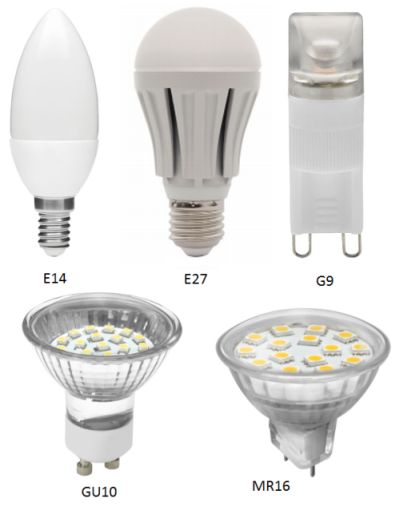
Types of LED lamp bases
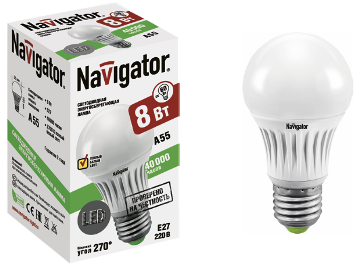
As for the marking of LED lamps, it is similar to the marking of compact fluorescent lamps (CFLs), and on the packaging the manufacturer indicates comprehensive product information.In addition to the inscription LED, indicating that the lamp is LED, other lamp parameters are also reported. Consider in more detail, using the example of what is indicated on the package, and what these parameters are like.
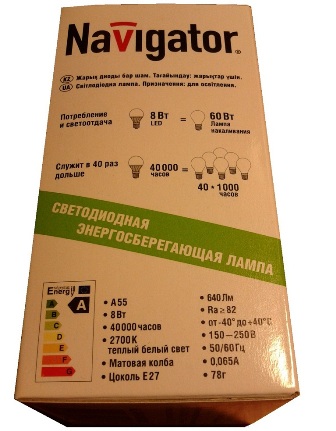
Power
The package must indicate the power consumed by this LED lamp from the network. As a rule, the package also indicates the equivalent luminous output power of incandescent lamps, but this equivalent parameter is provided only for comparison. Real power LED general purpose lamps, of those currently available for sale, ranges from 1 to 25 watts, depending on the needs of the buyer.
Comparison of LED amp with other types of lamps: Comparison of power and light output of different light sources
Life time
Service life in hours. This parameter may differ from one manufacturer to another, and according to statistics, the life of LED lamps in normal, not extreme conditions, with high-quality power from the network, can reach 50,000 hours.
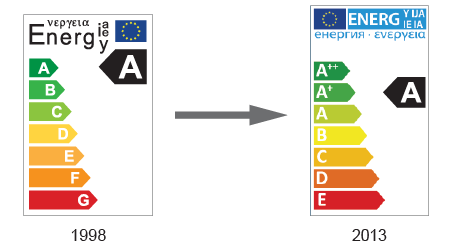
Energy efficiency class
Of course, LED lamps are very energy efficient, and the packaging is always indicated energy efficiency class. If earlier this indicator was limited to “A” level, then with the development of energy-efficient LED lighting, additional classes “A +” and “A ++” appeared, indicating a significantly lower value of the ratio of power consumption to power calculated from the effective lamp received from this lamp luminous flux.
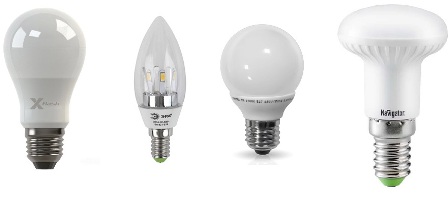
Bulb type
In this example, the type of bulb A55 is indicated - a standard shape, like a conventional incandescent lamp. There are other options: C35 - a candle, G45 - a ball, R39, R50, R63 - SLR, and others. The flask can be matte or transparent, as indicated on the package.
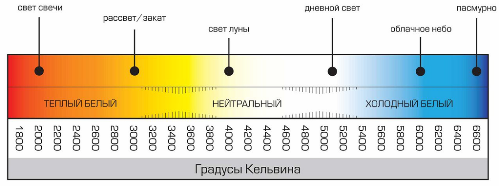
Colour temperature
It can be different, from very warm to very cold, and a more “warm” light is more comfortable for a person, closer to yellow, as is the case with incandescent lamps. Cold light is more suitable for industrial premises, street lighting and other places where a person does not seek to get the maximum comfort, and if cold light is installed in a living room, this will adversely affect the human nervous system. On the packaging, this indicator must be indicated.
The color temperature is measured in Kelvin, and the ranges have the corresponding names when marked: warm white light (2700-3200 K), neutral white or daylight (3500-4500 K), white light (4700 - 6000 K), cold white light (from 6000 K).
Light flow
The brightness indicator of an LED lamp, measured in Lumens. For clarity, you can use the table, and get an idea of the luminous flux that ordinary incandescent lamps give. Of course, LED lamps are able to give the corresponding luminous flux, consuming 7-10 times less electrical energy.

Color Rendering Index Ra
For sunlight this color rendering index equal to 100, for incandescent lamps - from 90 and above, for LEDs - from 80 to 89. This indicator reflects how close to its natural color the body remains illuminated by this light source. A value of Ra greater than 80 is generally considered quite high.
Consumption parameters
The above example shows that this LED lamp can operate at temperatures from -40 to +40 degrees Celsius, can be supplied with alternating voltage from 150 to 250 V, frequency 50/60 Hz, while the maximum (peak) current consumption is 0.065 A .
Read also on this topic: How are LED lamps
See also at e.imadeself.com
:
